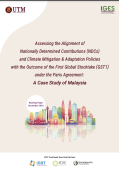This case study aims to establish the contribution of Ethiopian forests to national income by assessing the value added of the forestry sector, the contribution of forest ecosystems to other sectors, and the annual contribution of forest ecosystems to non-market income. Prior to this study, no full assessment of the income derived from forest-derived goods and services had been undertaken. The only figure available had been the official estimate of the contribution of the forestry industry to GDP (3.8% in 2012-13). By assessing the full contribution of forests to market and non-market income, a more complete picture of their economic importance emerges.
Overall, the study found that current GDP estimates undervalue the contribution of the forestry sector to both national income and other sectors. Specifically, the results showed that:
- Ethiopian forests generated economic benefits in the form of cash and in-kind income equivalent to USD16.7 billion or 12.8% of GDP in 2012-13. Of this, 6.1% of GDP is attributed to forest industries; and
- The largest market income benefits were associated with flows of wood fuel (firewood and charcoal) and livestock fodder. Together, these accounted for 62% of forest use benefits (USD10.3 billion).
These findings have implications for policy and decision making in Ethiopia. For instance, they can help strengthen the national REDD+ process by permitting the Ministry of Finance and Economic Cooperation, the Central Statistical Agency, and the Ministry of Agriculture to better understand the extent to which Ethiopia’s forests underpin the economy. This could provide the basis for updating Ethiopia’s System of National Accounts (ESNA) with a more accurate account of forest-derived benefits in GDP and developing a satellite forest account. In addition, the results and recommendations could be incorporated in the REDD+ National Strategy and potentially also in Ethiopia’s Growth and Transformation Plan 2 (GTP2).


